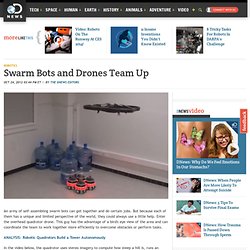

Swarm Bots and Drones Team Up. An army of self-assembling swarm bots can get together and do certain jobs.

But because each of them has a unique and limited perspective of the world, they could always use a little help. Enter the overhead quadrotor drone. This guy has the advantage of a bird's eye view of the area and can coordinate the team to work together more efficiently to overcome obstacles or perform tasks. ANALYSIS: Robotic Quadrotors Build a Tower Autonomously In the video below, the quadrotor uses stereo imagery to compute how steep a hill is, runs an onboard simulation to see how many ground robots will have to team up to make it over and then directs the robots to team up and go over the bridge. [IROS 2012] AR Drone Helps Swarm of Self-Assembling Robots to Overcome Obstacles.
We’re used to thinking of robot swarms as consisting of lots and lots of similar robots working together.
![[IROS 2012] AR Drone Helps Swarm of Self-Assembling Robots to Overcome Obstacles](http://cdn.pearltrees.com/s/pic/th/assembling-overcome-obstacles-42618784)
What we’re starting to see now, though, are swarms of heterogeneous robots, where you get different robots combining their powers to make each other more efficient and more capable. One of the first projects to really make this work was Swarmanoid, with teams of footbots and handbots and eyebots, and researchers presented a similar idea at IROS earlier this month, using an AR Drone to help a swarm of self-assembling ground robots to climb over a hill. The focus of this research is communication: getting a flying robot to be able to communicate with a swarm of ground robots by relying exclusively on visual feedback from LEDs.
All you need to get this to work are lights, cameras, and some mildly intelligent robots: you can leave your maps, GPS, IMU, hardware IDs, and all that stuff at home. Swarmanoid Robot Teams Up with Itself to Steal Your Books. Kilobots Are Cheap Enough to Swarm in the Thousands. Swarm. Robotic Quadcopters Build a Tower Autonomously. A swarm of autonomous, mini-helicopters have built a toy tower, demonstrating that machines could one day build structures without humans present.

This could keep humans out of dangerous areas, such as when building super tall skyscrapers or even construction buildings in war zones. The quadrotors, developed by the GRASP Lab at the University of Pennsylvania, move around, assemble small girders and work together thanks to an algorithm written by Daniel Mellinger and his colleagues. The building commands are sent to the quadrotors wirelessly.